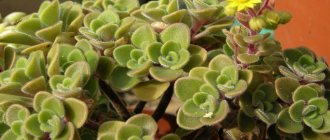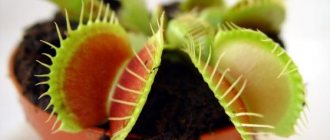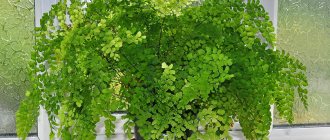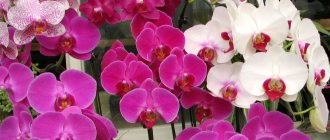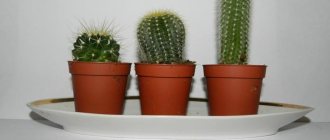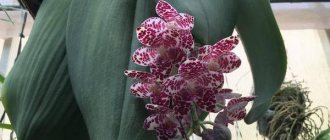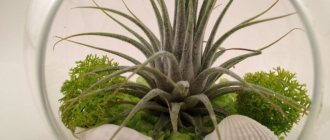Dieffenbachia is an evergreen plant that is of interest to those who like to decorate apartments and garden plots. The flower was named in honor of Joseph Dieffenbach, who served as the head gardener of the Austrian Imperial Botanical Garden in the 19th century. Thanks to its variegated leaves, the plant is often used as an indoor plant. However, its poisonous properties cast doubt on the advisability of such a neighborhood.
What kind of plant is this, is it possible to keep Dieffenbachia at home, how is it dangerous for humans and is there any benefit from it? - let's find out. And also what to do if your skin or eyes are burned by Dieffenbachia juice and if you have food poisoning.
Botanical description
Dieffenbachia belongs to the genus of evergreen plants of the Araceae family. It has a developed root system and a thick juicy stem. When grown at home, its height reaches from 0.5 to 2 m.
Dieffenbachia leaves have an oblong shape and are alternately arranged on the stem. They are painted yellow-green, which is beautifully set off by a marble pattern of spots or stripes. Drops of liquid periodically appear at the tips of Dieffenbachia leaves; these “tears” indicate increased air humidity and can predict imminent rain.
Dieffenbachia blooms in the spring, usually in April or May. But when kept at home, this rarely happens. The decorative value of Dieffenbachia is associated with the variegated pattern of the leaves. The small flowers, collected in a spadix, have an attractive yellowish-white hue.
Dieffenbachia is a poisonous plant. Its species that can cause intoxication, and are often grown at home, are as follows.
- Variegated Dieffenbachia - has a characteristic marble pattern of light spots and stripes.
- Oersted - leaves painted a solid green color with a white streak in the middle.
- Spotted Dieffenbachia - its name comes from its large light spots.
- Leopolda - dark green leaves with light veins.
- Lovely Dieffenbachia - decorated with large leaves up to 50 cm and a tall stem up to 1.5 m.
- White flame - the leaf pattern resembles tongues of fire.
The systematization of Dieffenbachia varieties is very confusing. However, the beginning of existing ornamental plants was laid by the selection of two varieties - spotted and variegated.
In nature, Dieffenbachia grows in the tropical forests of South and Central America.
For pets
Having learned whether Dieffenbachia is poisonous to people, let’s look at the situation with pets. Cats are very persistent in their desires, and if she decides to try this plant, rest assured, these cunning animals will get their way. When you're at home, you can ward off annoying foodies, but what happens when they're left alone? To avoid disaster, it is better to keep animals and Dieffenbachia in different rooms. Where the dangerous beauty will live, there is no place for curious four-legged creatures.
However, you should not fall into despair now, having discovered that that gorgeous flower that has been living with you for quite a decent time is nothing more than a poisonous Dieffenbachia. And at the same time, your beloved cat lives with you in the same rather modest living space. If he hasn’t touched the flower yet, then most likely he won’t do it.
Dogs can also taste Dieffenbachia, so it's worth taking safety precautions. The same goes for parrots. They can pinch off a piece of juicy greenery... For parrots, such a meal with a high degree of probability may be their last.
Beneficial features
The history of Dieffenbachia cultivation is almost two hundred years old. Such a long acquaintance allowed us to study the plant in many ways, including as an object for decorative use at home.
Useful properties of Dieffenbachia:
- regulates indoor air humidity, promotes dust settling on the surface;
- releases phytoncides - biological active substances that suppress the growth and development of pathogenic bacteria;
- absorbs harmful components of exhaust gases;
- neutralizes toxic substances contained in finishing materials of residential premises, cleaning products and detergents.
However, the positive qualities of Dieffenbachia do not negate the danger of this plant, since its juice contains poison. It contains oxalic acid, its derivative calcium oxalate, alkaloids, and essential oils. The flower can cause significant harm to the health of people and pets.
Features of care
As an indoor flower, Dieffenbachia is quite capricious and causes a lot of trouble for its owners. The plant loves light, but direct sunlight can discolor the leaves. In extreme heat, it is better to move it away from the windowsill. Make sure that there are no drafts nearby and that it is warm enough.
Dieffenbachia is demanding on humidity levels because it is a tropical plant. Try to spray the leaves as often as possible and wipe with a damp cloth. At the same time, there is no need to flood the plant with water, otherwise the roots may rot. They can be carefully trimmed and renew the soil. Planned transplantation is performed every 3 years.
However, we should talk in more detail about a plant such as Dieffenbachia. Its benefits and harms are precisely those aspects that need to be highlighted. Of course, let's start with the positive qualities.
Why is Dieffenbachia flower dangerous for humans?
Oxalic acid harms biological tissues of the body. It has a destructive effect upon contact with the skin, mucous membrane of the mouth, pharynx and larynx. It is based on irritation followed by inflammation and the appearance of a chemical burn reaction. There is evidence that the volatile components of Dieffenbachia juice can provoke irritation of the nasal mucosa, upper respiratory tract, eyes, and headaches.
Dieffenbachia can cause allergies. The risk group includes people with reactions to dust, pets, and citrus fruits.
When processing a plant without using gloves, the poisonous juice from the hands gets into the mucous membrane of the eyes.
Dieffenbachia leaves and flowers can be unintentionally eaten by a child. Pets are at the same risk.
Esotericists believe that Dieffenbachia is included in the list of plants that can change the energetic atmosphere of a home. Energy practitioners attribute the following properties to it:
- disrupts the harmony in the relationship of married couples;
- negatively affects potency in men, leading to infertility;
- prevents girls from matrimonial plans;
- extinguishes the negative energy of quarrels and family discord.
Such information may seem contradictory and exaggerated. However, it is worth remembering that the flower is popularly called muzhegon; it is perceived as a symbol of celibacy. Therefore, it cannot be ruled out that Dieffenbachia, which is poisonous to humans, releases substances that negatively affect reproductive function during prolonged contact.
Why is Dieffenbachia dangerous?
Causes of Dieffenbachia poisoning
Intoxication can occur:
- through the skin;
- mucous membranes;
- by inhalation;
- by the food route when it enters the gastrointestinal tract.
Most cases of Dieffenbachia poisoning occur through contact with skin or mucous membranes. You can usually avoid the plant's toxic effects by being careful, but children and pets are always the weak link. They may use an unconventional method to become acquainted with an attractive flower - chew parts of the plant, pick off the leaves, and then rub their eyes.
When bringing Dieffenbachia into the house, adults should be aware that their child can be poisoned by a poisonous plant, suffering a burn to the skin, eyes, mucous membranes, or digestive upset.
Why you can’t keep Dieffenbachia at home according to signs and superstitions
There are a large number of negative signs and superstitions associated with growing a flower in the house:
- Deterioration of financial condition. There is a belief that the plant scares away material well-being. In the house where the flower grows, there is an acute shortage of money, even to the point of poverty.
- A house without guests. The flower scares away visitors with its heavy energy. In a room with a plant, guests feel uncomfortable, try to leave the house quickly and have no desire to return there.
- Misunderstanding between generations. It is believed that Dieffenbachia causes discord in the relationship between children and parents.
Dieffenbachia in the room - Infertility. There is a sign that the flower in every possible way prevents the appearance of a baby in the house.
- Impotence. The plant depresses male power and contributes to loss of interest in women.
- Adultery. Placing a flower in the bedroom contributes to the loss of interest in each other.
- "Mosogyny flower." It is believed that the plant should not be grown by unmarried girls. The flower is jealous of its owner and does not allow men near her.
- Scandal generator. Dieffenbachia in the house provokes family quarrels and scandals.
- Pest. There is a belief that the plant has a bad effect on the human nervous system. Those who own the flower experience disturbed sleep and develop neurosis.
- Loss of a pet. Popular superstitions say that animals do not take root in a house where Dieffenbachia grows. They either leave or die.
The signs about the positive influence of the plant are an order of magnitude smaller, but they still exist:
- Danger warning. The plant blooms extremely rarely. But if it blooms, you should be extremely attentive and careful. By flowering, the plant signals impending major troubles. It may not be possible to turn them away, but “forewarned is forearmed.”
- New business. The plant contributes in every possible way to the development of new business.
- Great career. The flower loves business people, so it helps them climb the career ladder. But the plant should be placed directly at the workplace.
- Office assistant. Placing a flower in the office promotes success at work.
- Tutor plant. Flowers in educational institutions help students master larger amounts of information, develop intelligence and mental abilities.
On a note!
From all of the above, we can conclude that folk wisdom advises growing this plant at work, and it is better to refuse to keep it in the house.
Skin burn
The poisonous juice of Dieffenbachia comes into contact with unprotected tissues during processing of the plant, cutting off leaves, stems, and peduncles. Therefore, in order to avoid poisoning, any interaction with the flower must be carried out with gloves.
Symptoms will resemble a skin burn:
- acute pain;
- burning, itching;
- redness, swelling of the site of contact with the poison.
How to treat a skin burn from exposure to Dieffenbachia? It is enough to quickly wash off the juice with running water, including rinsing your mouth and nose. Do not rub the skin in an attempt to completely remove the aggressive substance. For severe pain, you can take a drug with an analgesic effect.
Let's sum it up
As it becomes clear from our article, Dieffenbachia is poisonous, but will only cause harm if it is treated negligently. If you do not chew the plant and work with it, protecting your hands with gloves, horrors will not happen. But the benefits of the flower are significantly reduced. Excellent cleaning properties should not be ignored. It is quite acceptable to keep it in office and industrial premises, in residential apartments and houses. It is enough just to stop communication between your child and the plant and to delimit the presence of animals together with him.
Burn of mucous membrane
A special case when toxic substances settle on the mucous membrane of the nose, oral cavity, and larynx. Signs of Dieffenbachia poisoning indicate acute respiratory failure:
- burning sensation, pain, soreness;
- increased respiratory movements;
- dry whistling cough;
- dyspnea.
If swelling of the mucous membrane causes obstruction of the respiratory tract, there is a threat to human life. Symptoms of insufficient oxygen supply to the body may appear:
- bluish skin;
- depression of consciousness;
- decreased blood pressure;
- development of a terminal condition.
It is necessary to immediately call an ambulance and do not leave the victim alone until medical specialists arrive. Monitor his consciousness, breathing, blood pressure, heart rate. If a terminal condition develops, begin cardiopulmonary resuscitation.
If Dieffenbachia juice gets into the eyes, a burn appears, the depth of which may vary. The severity depends on the concentration and time of exposure to the damaging factor. The victim may complain of pain, burning, swelling, inability to open the affected eye, lacrimation, and blurred vision.
What to do if your eyes are burned by Dieffenbachia juice?
- Rinse the cavity with a stream of water so that the liquid does not get on the healthy side, applying a protective bandage to the unaffected eye (especially important for children).
- Seek medical attention immediately.
A hardware and clinical examination will be carried out at the emergency room. Only a medical specialist can adequately assess the depth of the lesion. The doctor will prescribe a comprehensive treatment - analgesics, if there are indications - antibacterial, healing drugs, physiotherapeutic procedures. If necessary, the victim is hospitalized in a hospital.
Attitude to the plant in ancient times
The first mention of the plant came to us from the 18th century from Vienna, where biologists began cultivating it in the botanical garden. Dieffenbachia arrived in Europe from South America and got its name in honor of the Austrian gardener Joseph Dieffenbach. The bad reputation of Dieffenbachia dates back to ancient times.
Dieffenbachia
Because this plant is poisonous, it was used as an instrument of torture. Dieffenbachia juice was mainly used to punish guilty slaves. The venom is not toxic enough to kill an adult, but is nevertheless strong enough to cause significant suffering.
The person being punished was forced to chew Dieffenbachia leaves, after which he could not speak due to swelling of the tongue and burns of the mucous membranes of the mouth. This procedure was extremely unpleasant for the slave, but did not interfere with his work in any way, and therefore was used quite often.
Allergy to Dieffenbachia
What to do if Dieffenbachia juice gets on your skin and causes an allergic reaction? Symptoms can be divided into local and general.
If a localized rash, itching, or blisters appears, take antihistamines and monitor the body's reaction. If further development of symptoms does not occur, then the following conclusions should be drawn:
- the impact was local;
- next time the reaction will be more violent and unpredictable.
General symptoms occur with the development of acute respiratory and cardiovascular failure. The severity of the condition requires immediate hospitalization and intensive care in the intensive care unit.
All the positives
To answer the question of what kind of flower Dieffenbachia is and whether it can be kept at home, you need to pay attention to the positive aspects of this plant. When properly placed in the house, it can help its owners. Signs speak of several positive properties:
- It is best for the owner of the flower to be a woman. Then he will give her energy to maintain beauty and youth.
- If you keep it in the living room where no one lives, then the Dieffenbachia will give off energy. It is believed that the flower can help by energizing a person for success and well-being. To do this, you just need to walk past the flower or stand next to it.
- Based on the state of the plant, you can determine what awaits you. If its leaves begin to wither for no reason, then you should expect discord in the family, separation of lovers.
- If you take good care of a flower, your worldview will change in a positive way. He will give you the strength to defeat your enemies.
In order for the plant to give you positive energy, you need to properly care for it, then it will become a real helper.
Food poisoning
If you eat parts of the Dieffenbachia plant, it will initially show signs of burning. These include:
- pain, burning, itching, tingling;
- in the case of children - motor and emotional agitation, inability to come to an agreement or fulfill requests;
- swelling and redness of the lips, oral mucosa;
- increased salivation;
- difficulty breathing, swallowing, producing sounds (speech).
Later the symptoms of food poisoning appear:
- nausea;
- vomit;
- pain;
- pain in the stomach area;
- diarrhea (frequent loose stools).
What to do in case of Dieffenbachia food poisoning, for example, if a child has eaten a poisonous plant? Immediate medical attention will help neutralize the toxic substance. Independent lavage of the stomach and even the oral cavity can cause complications in the form of aspiration (flow of gastric contents into the respiratory tract) and spread of the burn area. This occurs against the background of difficulty swallowing, breathing, and the inability to communicate calmly. Severe sudden pain causes fear and inappropriate behavior of the child. Before the ambulance arrives, adults should distract him and provide psychological support.
Specialized treatment for Dieffenbachia food poisoning includes:
- adequate pain relief;
- hardware diagnostics (FGDS);
- gastric lavage;
- infusion (intravenous drip) of saline solutions;
- respiratory therapy - humidified oxygen, artificial ventilation;
- correction of gastrointestinal tract functions;
- prevention of complications.
The prognosis for the development of complications after Dieffenbachia food poisoning depends on how soon intensive therapy is started. The decisive factor in the fight against poison is time. Rapid removal of toxins from the gastrointestinal tract significantly reduces their absorption.
Air cleaning
Each of us must have furniture in our apartment. Did you know that formaldehyde and other harmful substances that release toxins into the air are used in the manufacture of tables, chairs, cabinets and beds?
Dieffenbachia absorbs them well, releasing oxygen. The plant also purifies the air from xylene and toluene and absorbs harmful fumes that are released when working with household chemicals.
It is not surprising that this home flower is recommended to be grown by all those who live near large industrial enterprises, highways, and in megacities.
